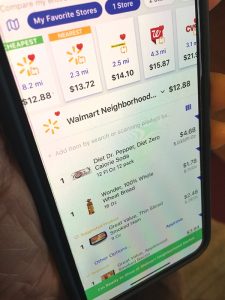The Supply Side: Basket looks to help suppliers, consumers with price transparency
by February 20, 2019 1:00 pm 791 views

Consumer households spend an average of $10,500 annually on food and consumables, according to the U.S. Department of Agriculture. While that comprises a big part of household spending, it’s also the part with the least amount of price transparency, according to Andy Ellwood, president and co-founder of Basket, a mobile app to help shoppers do grocery price comparisons with real-time data.
“Consumers can easier compare prices of hotels, airfare, cars and houses online, but in 2014 there was no way for us to easily price check a basket of groceries among all the retailers in a certain area,” Ellwood said.
He said Basket, a startup based in Arlington, Va., came about because his partner Neil Kataria, co-founder and CEO, tried to do his own price comparison five years ago after his family got an Amazon shipment. Kataria has three kids and a wife who’s a surgeon, creating a very busy household. He chose Amazon for convenience, with no idea how the cost compared to shopping locally.
“Neil decided one day to take his Amazon receipt and do some price comparisons to see what the same items would cost if he went to a local store to buy them,” Ellwood said. “He spent 12 hours in stores looking at discounts, comparing various sizes, coupon and loyalty offers and still couldn’t figure out exactly what his savings would have been.”
That prompted the duo to solve the pricing transparency issue around groceries. They each had some prior success with startups including the traffic/GPS app Waze, which was sold to Google in 2013 for $1.3 billion. Ellwood said he and Kataria launched Basket in 2014. And by the end of 2016, they had enlisted enough consumers via crowdsourcing to help provide real-time price transparency across much of the U.S. Today, there have been more than 800,000 downloads of the app by consumers who want price transparency on everything from soda to trash bags.
The Basket app is free for consumers who can save anywhere between 25% and 35% on their groceries when using the app. The Northwest Arkansas Business Journal tested the app on a small basket of four items — Diet Dr. Pepper, sandwich ham, bacon and a loaf of bread. The app calculated the lowest overall price ($12.88) at a Walmart Neighborhood Market that was 8.2 miles away. The closest Walmart store, a Supercenter located 2.3 miles away, had a basket price of $13.72. Dollar General, located 2.5 miles away, had the same items for $14.10. Walgreens, located 4.5 miles away, charged $15.87 for the same items while CVS, just 3.1 miles away, priced the basket at $21.95. There was a $9.07 price difference from the highest to lowest. There was a difference of 84 cents between the basket prices at the Walmart Supercenter and the Neighborhood Market.

Ellwood said consumers might save a little by using the app on small baskets, but larger basket comparisons generally yield more savings. A fuller basket with more than 30 items cost $58.58 at Walmart, $69.24 at Aldi and $73.10 at Target. Other grocers such as Whole Foods and Harps Food Stores did not have up-to-date prices on the exact basket items in the region. In cases like that, Basket users can opt-in for substitutes.
“We hope our app gives shoppers more transparency on prices before they back out of their driveway on their next trip to the grocery store,” Ellwood said. “They no longer have to walk blindly into a store wondering what the basket of goods will cost them. We don’t care where our users shop. We just want them to have visibility into product pricing for the grocery items they buy.”
The company achieves the price data from thousands of shoppers who sign on as commerce moderators. It’s crowdsourcing similar to other apps such as Field Agent, which is based in Fayetteville. The role of the commerce moderators is to provide real-time pricing metrics across thousands of retail stores in the U.S. The moderators earn points through gamification and they can choose to be compensated through cash, gift cards or other perks. There is a waiting list to become a Basket moderator in Northwest Arkansas, according to the company’s website.
BASKET INSIGHTS
Ellwood said over the past three years, the company has built up a large amount of pricing data. By using machine learning and analytics, Basket can now spot pricing trends and glean category insights. That put the company in a position to launch a new business division in late 2018 geared toward helping product suppliers get pricing transparency across retailers and product competitors.
“We have seen really good traction since launching Basket Insights,” Ellwood said. “We have signed up 19 clients in the past couple of months who subscribe to this new service. We are working with large and niche brands who want up-to-date price tracking on their products across multiple retailers. This has not been available in the grocery space until now. Most of the data comes from post sales transactions and is not real-time on a large scale.”

Ellwood explained suppliers who sign up for the Basket Insights service select the products they want to track, the retailers and the cities. He said the basic level subscription might track 100 products in five cities at 10 different retailers. He said retailers like Lidl, Whole Foods and H-E-B have not previously been part of traditional pricing analytics. Basket Insights tracks 98% of the nation’s grocery stores including Amazon Prime, Jet and Peapod. He said one supplier who signed up for the basic plan has now increased its subscription to track 1,000 products.
“We use Basket’s grocery business intelligence tool to help confirm and plan some of our account specific marketing promotions that vary by market,” said Peter Sliwinski, senior marketing manager for Bel Brands USA cheeses. “With Basket Insights we can understand timing, breadth and depth of our competitor’s promotions, allowing for us to optimize our promotional spend and gain market share during key drive periods or other times when competition from price reductions are lower.”
Ellwood said up-and-coming brands are building around real-time data and these young companies are on a mission to find their spots on the shopping lists of consumers who want more transparency on everything from price to ingredient sourcing.
“These niche brands typically faced big hurdles getting actionable data from traditional means because they don’t already dominate retail shelves,” Ellwood said. “That is changing with real-time data and it’s fun to be part of the disruption.”
EDITOR’S NOTE: The Supply Side section of Talk Business & Politics focuses on the companies, organizations, issues and individuals engaged in providing products and services to retailers. The Supply Side is managed by Talk Business & Politics and sponsored by Propak Logistics.
